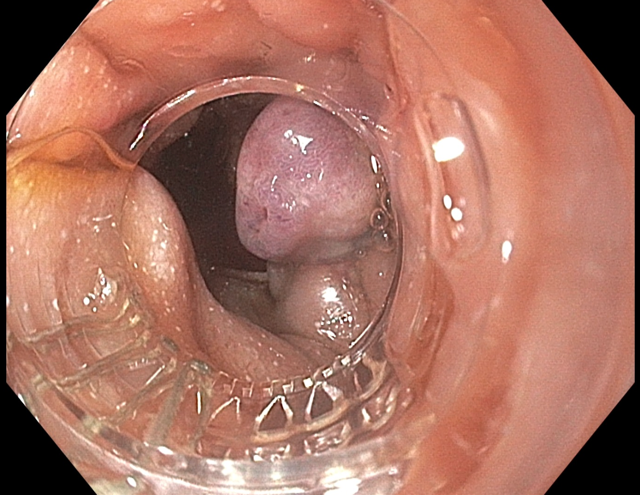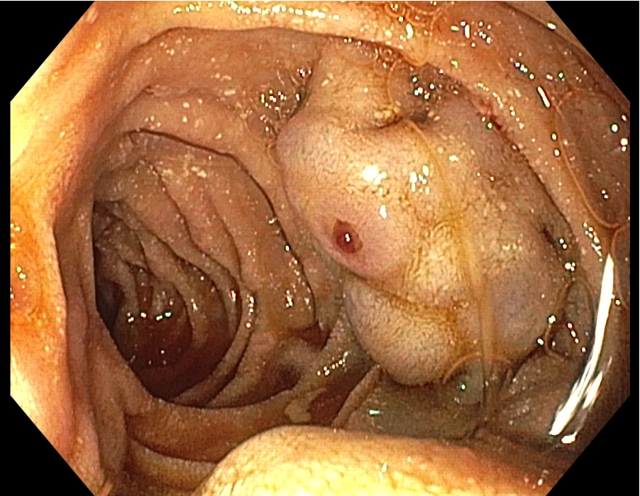Monday Poster Session
Category: GI Bleeding
P3143 - Duodenal Variceal Bleeding Secondary to Chronic SMV Occlusion in a Patient With a History of Pancreatic Neuroendocrine Tumor
Monday, October 27, 2025
10:30 AM - 4:00 PM PDT
Location: Exhibit Hall

Joelle Sleiman, MD
Staten Island University Hospital, Northwell Health
Staten Island, NY
Presenting Author(s)
Joelle Sleiman, MD, Tyler Grantham, MD, Vishnu Kumar, MD, Alia Hasham, MD
Staten Island University Hospital, Northwell Health, Staten Island, NY
Introduction: Duodenal varices are a rare yet life-threatening cause of upper gastrointestinal bleeding (UGIB) occurring in about 0.4% of cases of portal hypertension. They are most often associated with cirrhosis, although other causes of non-cirrhotic portal hypertension may also contribute. We present a case of duodenal varices exhibiting the nipple sign, resulting from chronic occlusion of the superior mesenteric vein.
Case Description/
Methods: A 66-year-old female with a history of pancreatic neuroendocrine carcinoma in remission presented to the Emergency Room with presyncope and hematochezia. Vitals were stable except for tachycardia, and labs showed a hemoglobin drop from 10.9 g/dL to 7.4 g/dL. Digital rectal exam confirmed bright red blood per rectum. CT angiography demonstrated intraluminal hypervascularity representing an impressive nexus of venous collaterals along the 4th segment of the duodenum and proximal jejunum, in the setting of chronic superior mesenteric vein occlusion secondary to prior pancreatic mass. Interventional radiology deemed the varices non-accessible for embolization due to a lack of transvenous or transarterial approach. The patient was started on a PPI infusion and octreotide infusion, received IV erythromycin, and underwent an emergent EGD, which revealed large, protruding varices in the second part of the duodenum and in the distal duodenum. The proximal varix exhibited a nipple sign (Figure 1). Variceal band ligation was successfully employed at each site, achieving hemostasis (Figure 2). The patient tolerated the procedure well. The bleeding stopped, the hemoglobin level remained stable, and there was no recurrence of bleeding.
Discussion: Duodenal varices, although rare, should be considered in patients with UGIB and a history of abdominal malignancy or portal hypertension. The optimal management remains uncertain, with most recommendations extrapolated from the treatment of other ectopic or gastric varices. This case highlights endoscopic band ligation as a successful and life-saving intervention for duodenal varices. However, long-term management is warranted due to the high risk of recurrence.

Figure: Figure 1: Endoscopic view of duodenal varices demonstrating the nipple sign.

Figure: Figure 2: Post-banding image of the duodenal varices
Disclosures:
Joelle Sleiman indicated no relevant financial relationships.
Tyler Grantham indicated no relevant financial relationships.
Vishnu Kumar indicated no relevant financial relationships.
Alia Hasham indicated no relevant financial relationships.
Joelle Sleiman, MD, Tyler Grantham, MD, Vishnu Kumar, MD, Alia Hasham, MD. P3143 - Duodenal Variceal Bleeding Secondary to Chronic SMV Occlusion in a Patient With a History of Pancreatic Neuroendocrine Tumor, ACG 2025 Annual Scientific Meeting Abstracts. Phoenix, AZ: American College of Gastroenterology.
Staten Island University Hospital, Northwell Health, Staten Island, NY
Introduction: Duodenal varices are a rare yet life-threatening cause of upper gastrointestinal bleeding (UGIB) occurring in about 0.4% of cases of portal hypertension. They are most often associated with cirrhosis, although other causes of non-cirrhotic portal hypertension may also contribute. We present a case of duodenal varices exhibiting the nipple sign, resulting from chronic occlusion of the superior mesenteric vein.
Case Description/
Methods: A 66-year-old female with a history of pancreatic neuroendocrine carcinoma in remission presented to the Emergency Room with presyncope and hematochezia. Vitals were stable except for tachycardia, and labs showed a hemoglobin drop from 10.9 g/dL to 7.4 g/dL. Digital rectal exam confirmed bright red blood per rectum. CT angiography demonstrated intraluminal hypervascularity representing an impressive nexus of venous collaterals along the 4th segment of the duodenum and proximal jejunum, in the setting of chronic superior mesenteric vein occlusion secondary to prior pancreatic mass. Interventional radiology deemed the varices non-accessible for embolization due to a lack of transvenous or transarterial approach. The patient was started on a PPI infusion and octreotide infusion, received IV erythromycin, and underwent an emergent EGD, which revealed large, protruding varices in the second part of the duodenum and in the distal duodenum. The proximal varix exhibited a nipple sign (Figure 1). Variceal band ligation was successfully employed at each site, achieving hemostasis (Figure 2). The patient tolerated the procedure well. The bleeding stopped, the hemoglobin level remained stable, and there was no recurrence of bleeding.
Discussion: Duodenal varices, although rare, should be considered in patients with UGIB and a history of abdominal malignancy or portal hypertension. The optimal management remains uncertain, with most recommendations extrapolated from the treatment of other ectopic or gastric varices. This case highlights endoscopic band ligation as a successful and life-saving intervention for duodenal varices. However, long-term management is warranted due to the high risk of recurrence.

Figure: Figure 1: Endoscopic view of duodenal varices demonstrating the nipple sign.

Figure: Figure 2: Post-banding image of the duodenal varices
Disclosures:
Joelle Sleiman indicated no relevant financial relationships.
Tyler Grantham indicated no relevant financial relationships.
Vishnu Kumar indicated no relevant financial relationships.
Alia Hasham indicated no relevant financial relationships.
Joelle Sleiman, MD, Tyler Grantham, MD, Vishnu Kumar, MD, Alia Hasham, MD. P3143 - Duodenal Variceal Bleeding Secondary to Chronic SMV Occlusion in a Patient With a History of Pancreatic Neuroendocrine Tumor, ACG 2025 Annual Scientific Meeting Abstracts. Phoenix, AZ: American College of Gastroenterology.
